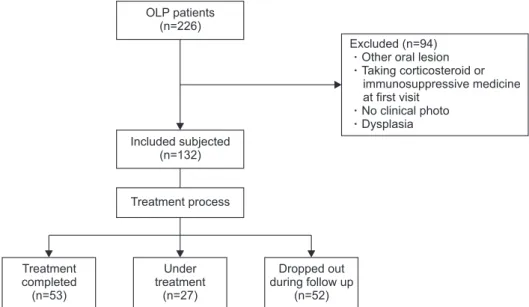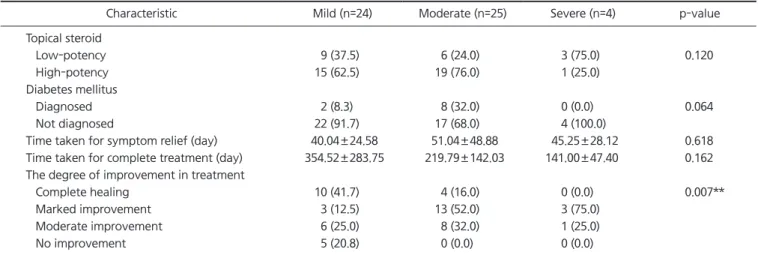pISSN 2288-9272 eISSN 2383-8493 J Oral Med Pain 2021;46(2):41-48 https://doi.org/10.14476/jomp.2021.46.2.41
Analysis of Treatment Response in Patients with Oral Lichen Planus
Hye-Min Ju 1 , Kyung-Hee Kim 2 , Hye-Mi Jeon 3 , Yong-Woo Ahn 4 , Soo-Min Ok 4 , Sung-Hee Jeong 4
1
Department of Oral Medicine, Pusan National University Dental Hospital, Dental Research Institute, Yangsan, Korea
2
Department of Oral Medicine, Inje University Busan Paik Hospital, Busan, Korea
3
Dental Clinic Center, Pusan National University Hospital, Busan, Korea
4
Department of Oral Medicine, Pusan National University, School of Dentistry, Dental Research Institute, Dental and Life Science Institute, Yangsan, Korea
Received May 28, 2021 Revised June 16, 2021 Accepted June 16, 2021
Purpose:
Purpose: To evaluate compliance by analyzing and comparing treatment duration, degree of improvement after treatment and treatment response of oral lichen planus (OLP) patients according to characteristics of them and the severity of the lesion.
Methods:
Methods: According to treatment process, 132 subjects with OLP who first visited the De- partment of Oral Medicine at the Pusan National University Dental Hospital from January 2017 to December 2020were classified into three groups: Treatment completed (CT) group, Under treatment (UT) group, and Dropped out during follow-up (DT) group. The reticula- tion/keratosis, erythema, and ulceration (REU) scoring system was used to assess the sever- ity of OLP. The degree of improvement after treatment was evaluated in CT group.
Results:
Results: There were 53 (40.15%) CT, 27 (20.45%) UT and 52 (39.39%) DT. In CT group, ac- cording to initial REU score there was a statistical difference in the degree of improvement, but not in the length of time to complete treatment. There was no statistical difference be- tween the days it took for patients to feel symptom relief, and the days of entire treatment among three groups. However, there was a positive correlation between the REU score of gingiva and duration of treatment in DT group. In the CT and DT groups, there was a corre- lation between the length of time taken to relieve symptoms and the duration of treatment.
Conclusions:
Conclusions: The severity of the gingival lesion and the initial response to treatment have a large effect on the entire treatment period and prognosis, so it should be considered when explaining the disease prognosis and treatment period to patients, and the clinician needs to focus on initial symptom relief.
Key Words:
Key Words: Long-term care; Oral lichen planus; Patient compliance
Correspondence to:
Sung-Hee Jeong
Department of Oral Medicine, Pusan National University, School of Dentistry, Dental Research Institute, Dental and Life Science Institute, 49 Busandaehak-ro, Mulgeum-eup, Yangsan 50612, Korea Tel: +82-55-360-5242
Fax: +82-55-360-5238 E-mail: drcookie@pusan.ac.kr
https://orcid.org/0000-0002-6296-4775 This work was supported by a 2-Year Research Grant of Pusan National University.
JOMP Journal of Oral Medicine and Pain
Copyright Ⓒ 2021 Korean Academy of Orofacial Pain and Oral Medicine. All rights reserved.
CC


